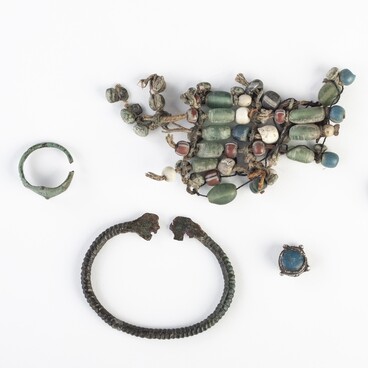The Kursk Regional Museum of Archaeology keeps a temple ring with the image of a bird. The ring was discovered in the Belovo district of the Kursk region. The ornament was broken into three parts, and part of the bow is missing. Five of the rays have ends in the form of a drop. Relief faux-grain borders along the edge of the rays form inner triangles with a smooth surface. The upper part of the plane in the form of a smooth convex band is decorated with a figure of a bird turned to the right. The head of the bird, turned backwards, has a very curved beak, a large bulging round eye, and a crest in the form of double-toothed “horns”. Its head is in contact with the bow, which has clearly visible bulges at the junction with the bow. The space between the rays and the surface of the wing are filled with scratched lines. The reverse side of the ring is smooth.
In the European part of Russia and Ukraine, along with temple rings with a single bird, there were found rings depicting a pair of birds, facing each other and standing one after the other. The closest analogue to all these scenes is found on the territory of the Byzantine Empire: a single stylized image of an eagle is featured in the upper part of a stamped Byzantine earring from Macedonia. Also, figures of birds of prey with their heads turned back, similar to the images on the rings from Kursk region and Korosten, are depicted on bone plates of the 10th–11th centuries from Chersonesos.
It is likely that early medieval Byzantine art depicted birds not only for aesthetic reasons, but also for symbolic and religious purposes. For example, the eagle represented resurrection and a new life beginning with the baptismal font, as well as the soul of the Christian, which is strengthened through virtue.
The motifs and stylistic techniques of depicting birds on temple rings found on the Slavic monuments of South-Eastern Europe coincide with the samples of Byzantine decorative and applied art of the 6th–12th centuries, so it makes it possible to associate temple rings (including the rings from the Belovo region and Korosten) with the early medieval Byzantine jewelry tradition. This tradition was widespread not only within the Byzantine Empire itself, but also in the lands seized by the Arabs from the Byzantians. When East European jewelers got their hands on these temple rings, they probably used them for secondary castings or as models for jewelry that combined both foreign elements and those that were familiar to their purchasers.
In the European part of Russia and Ukraine, along with temple rings with a single bird, there were found rings depicting a pair of birds, facing each other and standing one after the other. The closest analogue to all these scenes is found on the territory of the Byzantine Empire: a single stylized image of an eagle is featured in the upper part of a stamped Byzantine earring from Macedonia. Also, figures of birds of prey with their heads turned back, similar to the images on the rings from Kursk region and Korosten, are depicted on bone plates of the 10th–11th centuries from Chersonesos.
It is likely that early medieval Byzantine art depicted birds not only for aesthetic reasons, but also for symbolic and religious purposes. For example, the eagle represented resurrection and a new life beginning with the baptismal font, as well as the soul of the Christian, which is strengthened through virtue.
The motifs and stylistic techniques of depicting birds on temple rings found on the Slavic monuments of South-Eastern Europe coincide with the samples of Byzantine decorative and applied art of the 6th–12th centuries, so it makes it possible to associate temple rings (including the rings from the Belovo region and Korosten) with the early medieval Byzantine jewelry tradition. This tradition was widespread not only within the Byzantine Empire itself, but also in the lands seized by the Arabs from the Byzantians. When East European jewelers got their hands on these temple rings, they probably used them for secondary castings or as models for jewelry that combined both foreign elements and those that were familiar to their purchasers.





